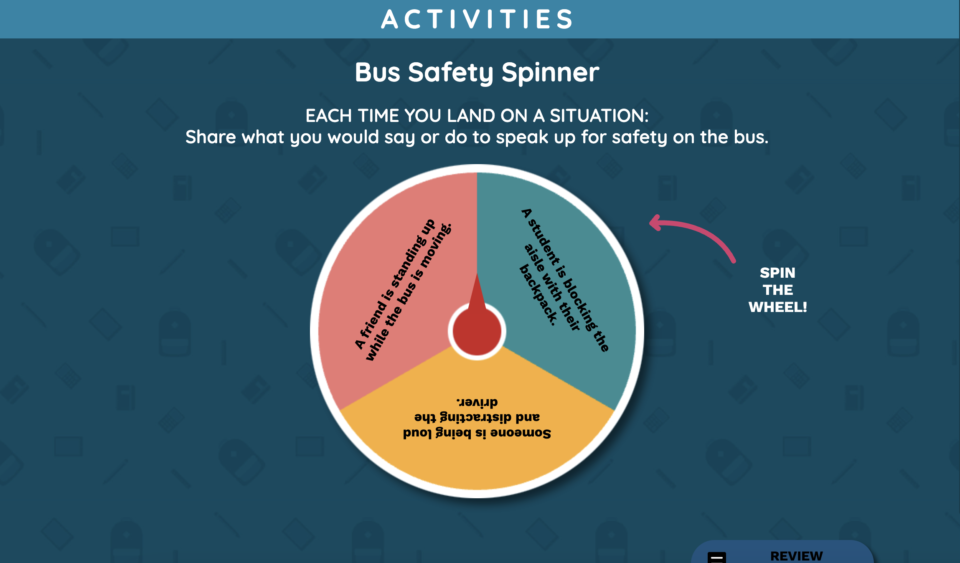
For many elementary students, riding the school bus is a daily experience and often one of their first steps toward independence. However, bus safety can be a challenge for young learners, who may not fully understand the importance of safe behaviors. As an elementary educator, you have a crucial role in teaching these skills. Everyday Speech’s Bus Safety Discussion Prompts offer a unique, interactive way to make these lessons engaging and memorable.
The “Bus Safety Discussion Prompts” from Everyday Speech are designed to spark conversations about real-life scenarios students might face on the bus. Using a fun, spinner-based activity, students can practice problem-solving and learn how to stay safe on the bus. Let’s explore how this activity can benefit your students and the best way to use it in your classroom.
What are Bus Safety Discussion Prompts?
The Bus Safety Discussion Prompts activity uses a spinner that lands on various bus safety scenarios. Each prompt encourages students to think about what they would say or do to address the situation safely. For example, they might land on a prompt like “A friend is standing up while the bus is moving,” and discuss how they would respond.
These discussion prompts are a part of Everyday Speech’s social-communication curriculum (SCC), specifically aimed at teaching responsibility in different settings. This activity makes bus safety a fun and interactive lesson, allowing students to practice making safe choices.
Benefits of Using Bus Safety Discussion Prompts in Your Classroom
Using the Bus Safety Discussion Prompts activity provides multiple benefits for students. Here’s how it helps enhance social and safety skills in your classroom.
1. Encourages Safe Decision-Making
The prompts guide students to think critically about safe choices. By discussing realistic situations, they learn to make responsible decisions on their own.
2. Builds Confidence and Independence
As students learn how to handle bus scenarios, they gain confidence in their ability to stay safe. This independence is essential for their growth and development.
3. Reinforces Respectful Communication
Many prompts involve speaking up or politely asking a friend to follow the rules. This builds respectful communication skills and encourages empathy.
4. Engages Students with Hands-On Learning
The spinner format keeps students engaged. Hands-on learning activities are more memorable, making it easier for students to recall and apply the lessons.

How to Use the Bus Safety Discussion Prompts in Your Classroom
Incorporating the Bus Safety Discussion Prompts activity into your lesson plans is easy. Here’s a step-by-step guide to help you make the most of this engaging tool.
Step 1: Introduce the Importance of Bus Safety
Begin by explaining why bus safety is important. Use simple language to discuss how following rules keeps everyone safe. You could say, “When we follow bus rules, everyone can have a safe and happy ride.”
Step 2: Explain the Activity
Show students the Bus Safety Spinner and explain that each prompt represents a scenario they might encounter on the bus. Tell them that their job is to think about what they would do to keep themselves and others safe.
Step 3: Spin the Wheel and Discuss
Spin the wheel to land on a scenario. For example, if it lands on “A friend is standing up while the bus is moving,” ask students to share what they would say or do. Encourage them to consider polite, effective responses that prioritize safety.
Step 4: Reinforce Positive Choices
As students share their answers, reinforce positive responses by acknowledging good ideas. This helps reinforce the value of making safe, thoughtful choices.
Step 5: Reflect on Lessons Learned
At the end of the activity, lead a group reflection. Ask questions like, “What did you learn about staying safe on the bus?” or “How can you help others follow the rules?” This reflection reinforces key lessons and allows students to share insights.
Sample Bus Safety Discussion Prompts and Suggested Responses
Here are some example prompts from the Bus Safety Discussion Prompts activity and possible responses you can discuss with your students.
- Prompt: A Friend is Standing Up While the Bus is Moving
- Suggested Response: “Please sit down while the bus is moving. It’s safer to stay in your seat.”
- Prompt: A Student is Blocking the Aisle with Their Backpack
- Suggested Response: “Could you move your backpack so people can walk through safely?”
- Prompt: Someone is Being Loud and Distracting the Driver
- Suggested Response: “Let’s talk quietly so the driver can focus on the road.”
Each of these scenarios provides students with practical ways to respond, promoting safety and respectful communication.
Tips for Maximizing the Effectiveness of the Bus Safety Discussion Prompts
To get the most out of the Bus Safety Discussion Prompts activity, consider these additional tips:
1. Encourage Empathy
Ask students to consider how others might feel if rules aren’t followed. For example, “How would you feel if someone blocked the aisle and you couldn’t get through?” This builds empathy and consideration for others.
2. Reinforce Calm and Polite Language
Teach students to use calm, polite language when addressing others. Role-play polite ways to ask friends to follow the rules, reinforcing positive communication.
3. Role-Playing Scenarios
If possible, role-play the scenarios in the classroom. Acting out the situations helps students practice responses in a safe, controlled environment, making it more likely they’ll remember the skills on the bus.
4. Review and Repeat
Revisit the activity periodically to reinforce the lessons. Repetition helps students internalize the safety practices and encourages consistent behavior.
Unlock more Riding the Bus materials by signing up for your free trial today – no credit card required!
Access the full Social Communication Curriculum HERE!
Instant access to thousands of no-prep social skills activities, over 1000+ video lessons, and engaging games designed to enhance learning and development.
Everyday Speech’s Resources for Teaching Safety and Social Skills
Everyday Speech provides a wide range of resources to help educators teach social skills and safety practices. The Bus Safety Discussion Prompts are part of a comprehensive social-emotional learning curriculum designed to make important lessons engaging and memorable.
Everyday Speech’s curriculum includes video modeling, interactive activities, and worksheets that simplify the process of teaching social and safety skills. These tools are essential for educators who want to create a positive, respectful environment where students feel safe and supported.
Conclusion: Building Safe Habits on the Bus
Teaching bus safety is a critical part of helping students navigate the school day with confidence and respect. Everyday Speech’s Bus Safety Discussion Prompts provide an interactive, engaging way to teach these important skills. Through real-life scenarios and guided discussions, students learn to handle common bus issues respectfully and effectively.
Incorporate the Bus Safety Discussion Prompts into your classroom to build students’ problem-solving skills, empathy, and independence. By preparing them for bus scenarios, you’re not only ensuring their safety but also fostering a respectful community. Give your students the tools they need to make every bus ride a safe and positive experience.
Sample Video
Students learn best by watching others their same-age model the behavior! Check out a sample video modeling lesson below. We offer our entire Social-Emotional Learning platform free for 14 days here!
Related Blog Posts:
Teaching Elementary Students Safe Bus Behavior
Video Modeling Lessons on Riding the Bus





